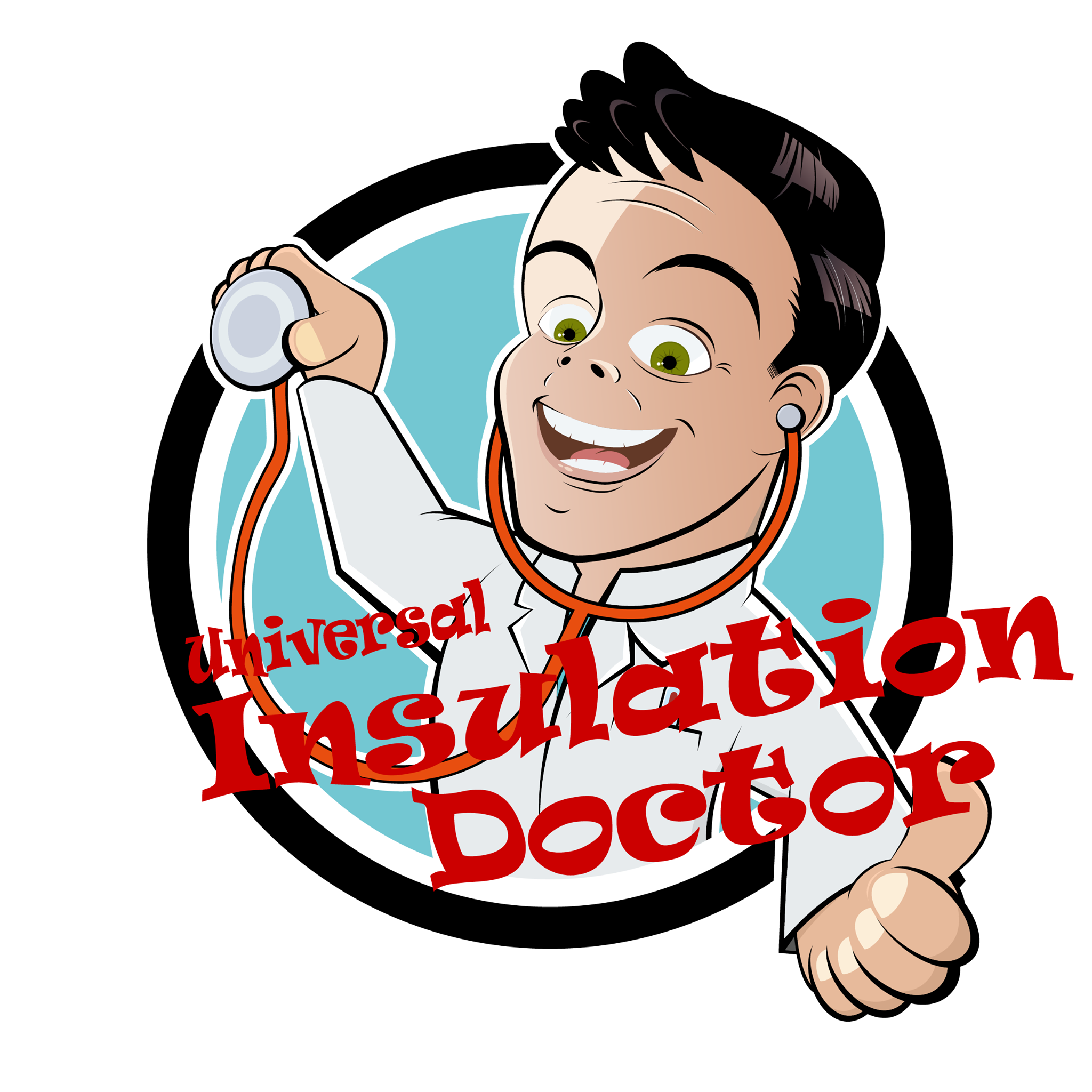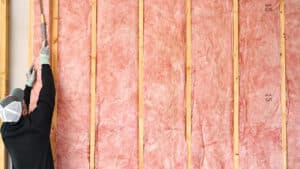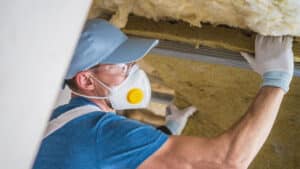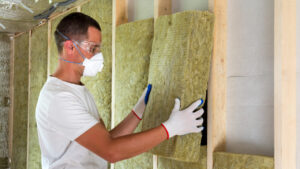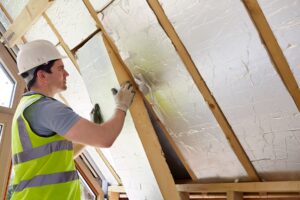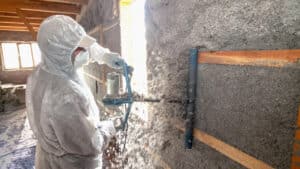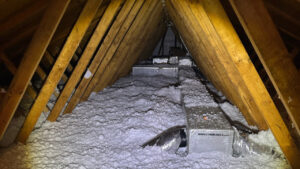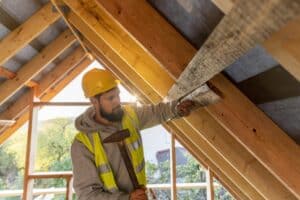As winter temperatures drop, older homes like the ones in the historic neighborhoods of Norfolk face unique challenges in maintaining warmth and energy efficiency. In this article we’ll be discussing some of the things you can learn from scheduling a winter insulation inspection for your older home.
We will be covering the critical aspects of winter home insulation inspections for older homes, reviewing the insulation types you might find and those tailored to address the specific needs of aging structures during the colder months.
Importance of Insulation During Winter Months

In the era before the 1960s, homes in Norfolk were often built without insulation due to the significantly low energy prices at the time. People freely used heaters or ACs without concerns about high bills. Fast forward to today, with increasing electricity costs and a growing emphasis on reducing carbon footprints, insulation has become vital for maintaining energy-efficient homes.
Now, especially during the cold winter months, the significance of insulation comes into play. Here’s why:
– Staying Warm: Insulation keeps the warmth inside your home, so you don’t feel chilly.
– Saving Energy: With good insulation, you use less energy to heat your home. This means a lower energy bill and helping the planet by using less power.
– Stopping Heat from Leaving: Without insulation, the warmth can escape through walls and floors. Insulation stops this heat from getting away, keeping your home nice and toasty.
– Protecting from the Cold: Insulation acts like a shield, keeping the freezing cold outside. This is especially important in older homes that might feel drafty.
– Preventing Dampness: Insulation helps control moisture buildup, stopping things like mold and dampness. It keeps your home dry and cozy.
– No More Cold Spots: Good insulation means no more cold areas in your home. Every room feels comfortable, and you can enjoy winter without feeling chilly indoors. Here are some other signs you can look for that tell you your home might be under insulated!
– Stopping Roof Troubles: In winter, insulation in the attic stops ice from causing problems on your roof. It helps in avoiding leaks and damage.
– Feeling Cozy: Insulation makes your home feel warm and comfy. It’s like wrapping your home in a warm hug, making it a nice place to be during winter.
In simple terms, insulation is like a superhero for your home in winter, making it warm, saving you money, and keeping everything snug and comfy.
Older Homes May Have Less Effective Attic Insulation
In older homes, attic insulation may not be as effective. If your residence is 30 years or older, it might lack attic insulation altogether. Alternatively, if you haven’t updated your insulation in years, it could be compressed, resulting in reduced effectiveness. In both cases, you may be losing money on your heating and cooling expenses daily.
The function of insulation is to capture small pockets of air, forming a barrier between indoor and outdoor temperatures. As these air pockets are immobilized, they cannot traverse the insulation to transfer their heat.
Over time, insulation tends to settle, encounter moisture, and may even suffer occasional compression from foot traffic. These factors force the air pockets out of the insulation, diminishing its efficacy. Therefore, whether due to age or compression, older homes may experience less efficient attic insulation.
Types of Insulation Ideal for Older Homes in Winter
When winter hits, keeping your home warm is crucial. From Fiberglass to Spray Foam, let’s dive into what works best to keep your home cozy in chilly weather.
Fiberglass Insulation
Widely available in various forms, fiberglass insulation is a versatile choice. For colder climates, Loose-fill Fiberglass Insulation, with an R-Value of 60, is optimal. It maintains its energy-saving capabilities over time, puts minimal stress on the attic floor, requires no additional fire-retardant material, doesn’t rot or decay, is eco-friendly, and resists mold, insects, and vermin.
Blown-In Insulation
Blown-In Cellulose Insulation, with an R-Value of 49, is ideal for cold climates. Effective in various temperatures, it excels in colder periods. Best used in ceilings, open wall cavities, unfinished attic floors, or other hard-to-reach places.
Spray Foam Insulation
While pricier than batt insulation, spray foam insulation boasts a significantly higher R-Value (3.5 to 6.5 per inch). It eliminates tasks like caulking by forming an air barrier as it settles. Starting as a liquid, it expands to fill spaces, sealing cracks, gaps, and leaks. Once transformed into rigid foam insulation, excess can be trimmed for an even surface.
Blanket, roll, and batt insulation are widely used but less effective. Portable and easy to install, they struggle in awkward spaces, are prone to compression, moisture, and mold. In some cases, they may lose up to 50% effectiveness, making them better suited for warmer, dryer climates. Aside from these major types there are other innovations up and coming in the insulation world that are worth learning about.
Signs of Potential Insulation Issues in Older Homes During Winter

Winter can be tough on older homes, and signs of insulation problems can emerge. Recognizing these indicators is crucial for maintaining a cozy and energy-efficient living space.
Here are signs that your older home might face insulation challenges in winter:
1. Uneven Temperature Distribution:
Problem: Inadequate insulation can lead to uneven temperatures throughout the home, with some rooms feeling colder than others.
Solution: Conduct a thorough assessment to identify areas with insufficient insulation. Add or upgrade insulation in specific areas to create a more balanced and comfortable indoor environment.
2. Cold or Damp Walls
Problem: Poor insulation can result in cold walls, leading to discomfort and potential issues such as condensation and mold growth.
Solution: Upgrade insulation in exterior-facing walls. Address any leaks or moisture sources to prevent dampness. Consider adding a vapor barrier to protect against moisture-related problems.
3. Drafts Near Windows and Doors:
Problem: Gaps or poor sealing around windows and doors can allow cold air drafts, reducing energy efficiency and causing discomfort.
Solution: Seal gaps with weatherstripping and caulking. Install draft stoppers. Consider upgrading to energy-efficient windows and doors to minimize heat loss.
4. High Heating Bills:
Problem: Inefficient insulation leads to increased energy consumption and higher energy costs.
Solution: Conduct a home energy audit to identify and address insuation deficiencies. Upgrade insulation in key areas and consider installing thermal window coverings to improve overall energy efficiency.
5. Ice Dams on Roof:
Problem: Uneven roof temperatures caused by poor attic insulation and ventilation can lead to ice dam formation, potentially causing water damage.
Solution: Improve attic insulation and ventilation. Seal air leaks in the attic. Install heat cables to prevent ice dams and protect the roof structure.
6. Visible Condensation:
Problem: Inadequate insulation and ventilation result in condensation on windows, potentially leading to mold growth.
Solution: Upgrade insulation and windows. Enhance ventilation to control indoor humidity levels. Consider using dehumidifiers in areas prone to excess moisture.
7. Cold Floors:
Problem: Inadequate insulation in crawlspaces or beneath floors leads to cold indoor surfaces.
Solution: Add or upgrade insulation in crawlspaces. Seal gaps and cracks in the foundation. Use area rugs to minimize heat loss through floors.
8. Increased HVAC System Operation:
Problem: Heat loss due to poor insulation forces the HVAC system to work harder.
Solution: Upgrade insulation to reduce heat loss. Ensure the HVAC system is well-maintained, including regular cleaning and filter replacements. Consider a programmable thermostat for efficient temperature control.
9. Icicles Hanging from Eaves:
Problem: Uneven roof temperatures caused by poor attic insulation can lead to ice dam formation.
Solution: Enhance attic insulation and ventilation. Seal air leaks. Install heat cables to prevent ice dam formation. Consider a professional assessment for a comprehensive attic insulation upgrade.
10. Visible Mildew or Mold:
Problem: Insufficient insulation and ventilation result in excessive moisture, promoting mold growth.
Solution: Improve insulation and ventilation to reduce moisture levels. Remediate existing mold issues using appropriate cleaning methods. Ensure proper drainage around the foundation.
Knowing When Your Old Home Requires a Professional Inspection
If you are seeing any of the signs above it is time for an insulation inspection for both your home’s safety but also for your family’s health & well-being.
Regular inspections play a key role in upholding the comfort and efficiency of your older home.
Tips for Maintaining Insulation Effectiveness Throughout Winter
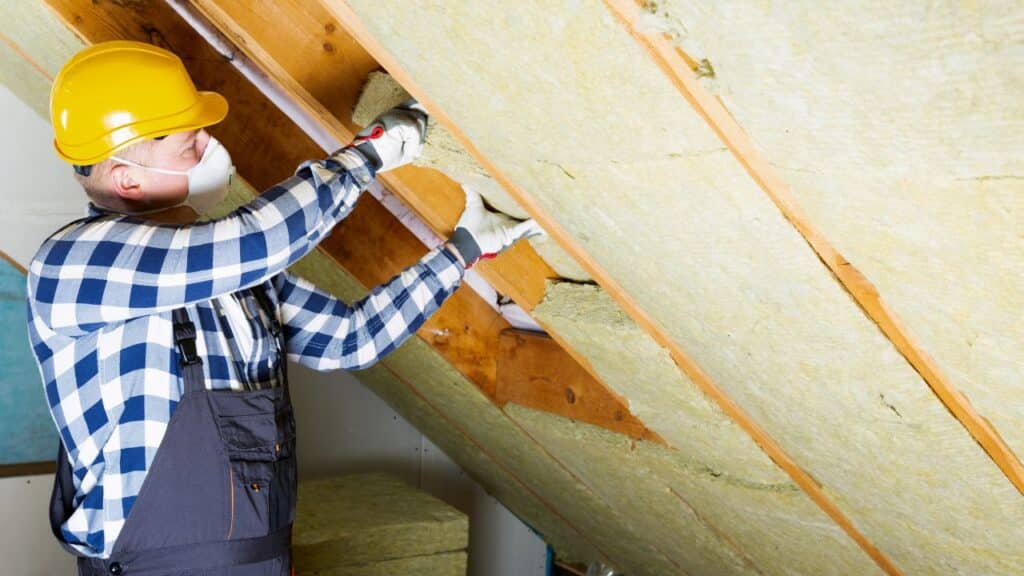
Here are some tips to ensure your insulation lasts during the winter months:
1. Check for Damages: Look for holes, tears, and water stains. If you spot damage, consult a professional to identify and address the source, ensuring timely repairs or replacements. You don’t want rodents and pests getting a head start burrowing into your insulation. Not all insulation is easy to see so do your best peaking into the spaces between walls and the cracks in your crawl spaces.
2. Check for Air Leaks: Keep an eye out for air leaks, as they compromise insulation. In both winter and summer, maintaining a regulated environment relies on preventing unwanted heat exchange through roof leaks.
3. Clean & Dry: Insulation performs best when clean and dry. Wet insulation, depending on the type, can significantly weaken its effectiveness.
4. Monitor Humidity Levels: Excessive humidity can lead to mold growth and moisture buildup, compromising insulation and posing health risks. Dehumidifying the air helps maintain insulation performance.
5. Insulation Placement: Avoid heavy compression of insulation, especially in commercial buildings with equipment and heavy items. Stack items carefully to prevent unwanted compression.
6. Full Insulation: Ensure all areas of your property are insulated to maintain uniform effectiveness. Gaps in insulation can undermine overall performance.
7. Hire a Professional: Enlist the services of a professional for regular inspections and maintenance. Professionals like us can ensure maximum performance, provide valuable recommendations, and offer insights into your building’s insulation health.
Call Universal Insulation Doctor for Trusted and Quality Insulation Services!

As winter approaches, trust Universal Insulation Doctor to safeguard your older home. Our experienced insulation contractors specialize in insulation for heritage properties, ensuring your home regains it’s warmth and energy-efficiency.
We handle winter insulation inspections with precision, respecting your home’s character. From attics to crawl spaces, we prioritize quality while maintaining architectural integrity.
Say goodbye to drafts and high bills—contact Universal Insulation Doctor for swift, precise, and professional insulation services, preparing your home seamlessly for the winter months.
Frequently Ask Questions
How to improve insulation in old home?
The first step will always be to get it inspected, preferably by a professional. Many older homes don't have insulation in Hampton Roads and others that do have not had it looked at in decades. The easiest way to improve insulation is to talk to a professional like us to help you decide what type of insulation, what R-value is appropriate, and identify any trouble areas you may encounter.
What is required for insulation inspection?
The only thing required for an insulation inspection is an appointment. Your technician will come over and hep prepare your home during the inspection. Ideally you do have an HVAC system that works or at least turns on, but we can get our eyes where we need it with specialized equipment if not!
How do you tell if an old house is insulated?
To check if an old house is insulated, visually inspect the attic, walls, and floors for materials like fiberglass. Look for insulation around electrical outlets on exterior walls. High energy bills could suggest poor insulation.
Consider a professional home energy audit for a more accurate assessment using tools like infrared cameras. Older homes may have less effective insulation, so consulting with a professional can provide helpful insights.
Are older homes more expensive to insure?
Yes, generally, older homes can be more expensive to insure. This is because the cost to replace or repair older homes may be higher, often due to unique materials, outdated systems, or not meeting current building codes.
Maintenance issues and the use of special features in older homes can also contribute to increased insurance premiums. However, homeowners can help manage costs by keeping up with maintenance, updating systems, and comparing insurance quotes to find the best coverage for their older home.
Does old insulation need to be removed?
Whether old insulation needs removal depends on its condition. If it's damaged, contaminated, or no longer effective, it's a good idea to replace it. During renovations, upgrading insulation for better efficiency might warrant removal. In cases where health risks are involved, such as with asbestos, professional removal is recommended. Assess the insulation's state and consult experts if needed to ensure a safe and effective decision.
